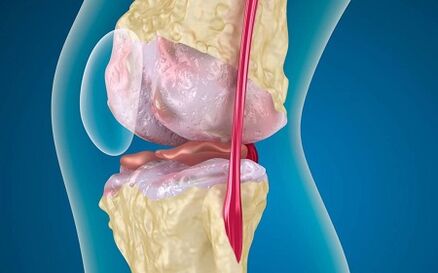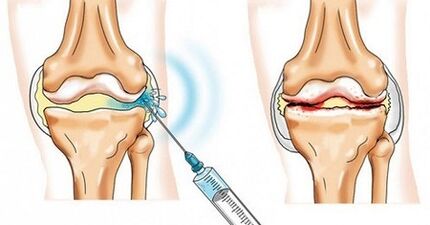
It is such an unpleasant disease of the musculoskeletal system as the osteoarthritis of the knee joint.From the article you can discover what type of disease it is, why, what are the main symptoms of the osteoarthritis of the knee and how to treat this insidious disease.
The osteoarthritis of the knee joint (another name - gonarrosis) is a chronic disease of the knee joint, which is called the joint destruction of the cartilage of the joint, followed by the deformation of the joint and the limiting motor activity.
Gonarrosis is the most common type of osteoarthritis.Most of the time, the disease is diagnosed in people 40 years or more.In the elderly group, knee osteoarthritis is more common in women, among younger patients, the disease is more frequently diagnosed in men.In approximately 7% of cases, the disease leads to the development of disability.
Reasons
The main causes of disease development are:
- Violation of metabolism in the body;
- excess weight, which leads to an increase in load in knee joints;
- greater fragility of the capillaries, several circulatory disorders;
- knee joint injuries (cracks, fractures, meniscus ruptures, ligaments);
- some endocrine diseases;
- Inflammatory joint diseases (arthritis, rheumatism);
- old injuries that were cured incorrectly;
- Traumatic sport classes for knees (heavy athletics, bodybuilding, football, gymnastics, tennis, athletics);
- hereditary predisposition;
- Congenital anomalies of the structure of the knee joint.
Types of osteoarthritis
The following types of osteoarthritis are distinguished by origin:
- primary- Most of the time it occurs in the elderly, at risk are patients with obesity;
- secondary- It develops after knee injuries or infectious diseases that cured incorrectly.
According to the location of the pathological process, the following types of knee osteosis are distinguished:
- Left side- It affects the left knee joint, observed more frequently in athletes and patients with obesity;
- Correct- It affects the right knee joint, it is most frequently found in athletes and people whose work is associated with an increase in dynamic and static loads in the right leg;
- bilateral- The most serious type of osteoarthritis of the knee joint, which can lead to disability, is most frequently found in older people.
Symptoms
The main clinical signs of the disease are:
- Knee pain: At first, pain occurs with an increase in physical effort in the joint, movement, running, walking and disappearing at rest, as the disease develops, patients arise when it comes to starting to move after a long rest period, a person with knee osteoarthritis is difficult to lower the stairs, over time, the knee pain becomes constant;
- Morning stiffness in the knee joint: it lasts approximately half an hour, over time it can increase the duration;
- Crunch in the knee when moving;
- With the development of the inflammatory process, patients complain about the feeling of heaviness in the knee, the joint is slightly swollen and increases in size;
- The form of the joint gradually changes, its deformation occurs;
- With the additional development of the disease, lameness appears, the movements in the knee joint are limited, the patient cannot completely print the painful leg;
- The atrophy of the femoral muscles develops gradually, become weak and flaccid, decrease in volume.
Treatment
When the first unpleasant symptoms appear, you must immediately consult a doctor and undergo an exam.The timely treatment will increase the chances of recovery and improve the prognosis.The car -medical is unacceptable and can lead to the development of a series of complications, to disability!
The treatment of knee osteoarthritis includes the following stages.
No therapy
- The painful articulation must guarantee rest, so that crutches or canes are used to download it;
- Ultraviolet irradiation, heat: to eliminate pain;
- Use special orthopedic shoes, knees, special templates;
- Massage, exercise therapy, physiotherapy: they are prescribed after stopping the acute stage of the disease.
Drug therapy

- Reception of NSAIDs inside (tablets) and externally (gels, ointments) - to relieve inflammation and knee pain;
- Special drug injections in joint cavity are carried out in the absence of the effect of NSAV;
- Slow systems: To normalize metabolic processes in cartilaginous tissue;
- Means to improve blood circulation: contribute to the normalization of blood circulation in the pathological approach and improve the supply of medicines to the damage zone.
Surgical intervention
It is shown with a complete loss of joint function and includes prostheses of the knee joint.
Health for you and your loved ones!























